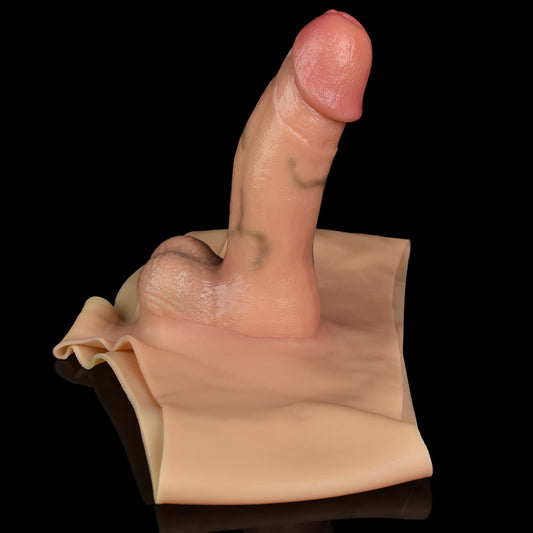
When Orgasm Isn't the End! Unveiling the Pleasure Mechanism of Post Orgasm Torture
Share
Why Are We "Overly Sensitive" Post Orgasm Torture?
When a person reaches orgasm, the brain releases a flood of neurotransmitters, including dopamine, oxytocin, and endorphins. The intense excitement brought on by orgasm is actually a concentrated discharge of the entire nervous system. Immediately afterward, the body enters a so-called "nervous fatigue phase," where nerve endings, particularly in the sexual organs, become extraordinarily sensitive for a short period.

Post-orgasmic sensitivity isn't just about "pain"; it's a complex and highly individualized neural response. At this point, the body has not fully "recovered" from orgasm—the sympathetic nervous system remains in an excited state, maintaining alertness and muscle tension.

Additionally, areas like the clitoris, which is densely packed with nerve endings (with over 8,000 nerve endings, double that of the glans penis), remain highly sensitive. Combined with the residual blood flow from orgasm, these areas are still engorged.

Stimulation during this phase is perceived by the brain as a "pleasure-pain mixed signal." Dr. Barry Komisaruk, a sex researcher, has pointed out that clitoral nerve activity remains heightened after orgasm, and an individual's tolerance for "excessive stimulation" varies, making it especially important to incorporate pauses and gentle rhythms during intimate interactions.
Why Do Some People Enjoy This "Torture"?
Orgasm isn’t the end, but a starting point for further exploration.
Many people view orgasm as a moment of "release" and "relaxation," but for others, the "aftershock" (Post-Orgasmic Time, or POT) becomes the gateway to even deeper pleasure.

According to a 2021 study in Archives of Sexual Behavior with 2,300 sexual preference participants, 27% said that the residual sensitivity after orgasm was a source of excitement for them to continue interacting, and nearly half of these individuals preferred to continue receiving stimulation during this phase, exploring their physical limits.
For some, the need for a higher pleasure threshold drives them to seek stronger, deeper, or psychologically intense ways to "satisfy" themselves.
Enjoying the psychological dynamic of control/loss of control: Especially in BDSM scenarios, POT becomes a tool for the dominant partner to control the rhythm, and it allows the submissive to experience a mix of shame, submission, and pleasure during the heightened sensitivity post-orgasm.
Fascination with "edge play": For some, it’s not about enjoying pain, but rather becoming addicted to the feeling of being pushed to the limits of body and senses.

It’s important to emphasize that POT isn’t about "enduring discomfort" but about a “sensual transition” built on trust, communication, and respect for the body. This experience is ideal for partners who want to turn sex into a deeper psychological game, but it’s not something everyone needs or is suited for.
Post-Orgasmic Experiences Across Genders
Penis Owners’ Post-Orgasmic State: From Sensitivity to "Untouchable"
For penis owners, the first reaction post-orgasm is often excessive sensitivity, especially in the glans. This period, known as the post-ejaculatory refractory period, is when the penis cannot immediately become erect again and may even reject further touch. Research indicates that most people in this phase need anywhere from 10 minutes to several hours of rest to regain sexual excitement.

However, post-orgasmic sensitivity doesn't necessarily signal the "end" of play. Some penis owners explore paths to "prolonged pleasure" during this refractory phase, even triggering multiple orgasms. Techniques like using a vibrating ring to maintain partial erection, gently licking the edge of the glans, or applying low-frequency electrical stimulation to create boundary pleasure can open up a new erotic journey that balances comfort and challenge, though these methods do require psychological and physical endurance.
Clitoris Owners’ Post-Orgasmic State: Over-Saturated Sensitivity Curve
For clitoris owners, post-orgasm often leads to an "over-sensitive" or "pleasure saturation" state where even the lightest touch can provoke a withdrawal response. This instinctual avoidance is actually a self-protection mechanism. However, because of this, indirect and gentler stimulation can open the door to continuous pleasure.

For clitoris owners, the "sensitive period" post-orgasm doesn’t always require a complete withdrawal from touch. If approached with delicate, subtle stimulation, pleasure may rise again. Techniques like using a low-frequency vibrating massager on the clitoral perimeter rather than directly on the core, using sucking toys to simulate gentle oral sensations, or lightly brushing the area with a soft bristle can induce a type of "tremor orgasm"—an experience where the pleasure radiates from the local area to the entire body, accompanied by mild shudders, deep convulsions, and emotional surges, reigniting the afterglow of pleasure.
Sensitivity Moment After Clitoral Orgasm: Building Deeper Emotional Bond
The high-sensitivity moment after orgasm isn’t just a physical challenge but also a test of trust and intimacy. The boundary exploration between pleasure and discomfort is not "torture," but an erotic art that requires deep communication and mutual respect. With clear safe words, mutual signals, and awareness of each other's bodily responses, this "control and surrender" dynamic can deepen the bond and understanding between partners.
If you or your partner are interested in this experience, consider starting with a gentle experiment, gradually recording and adjusting, and discovering your rhythm during this boundary-pushing exploration. LustBond offers a variety of tools designed for sensitive-period stimulation, from soft vibrating toys to adjustable-pressure BDSM accessories, helping you embark on this exploration more safely and enjoyably.









